Configuration
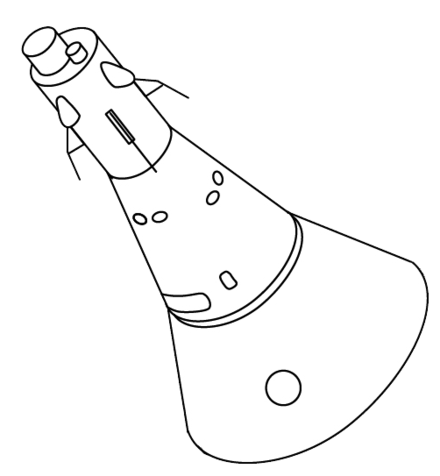
The spacecraft consisted of the following modules:
- ADU Emergency Engine Unit
- VA Capsule (crew module)
- PAB Equipment-Rocket System Block (service module)
- RB Translunar Injection Stage
| Manufacturer | OKB-52 |
|---|---|
| Country of origin | Soviet Union |
| Operator | Soviet space program |
| Applications | Carry cosmonauts around the Moon and back to Earth |
| Production | |
| Status | Canceled |
| Related spacecraft | |
| Derivatives | LK-700, TKS spacecraft |
LK-1 was a projected Soviet crewed lunar flyby spacecraft. It would be launched on a three-stage Proton launch vehicle. The project started in 1962 under the lead engineer Vladimir Chelomey, [1] with the first flight planned for 1967.
The LK-1 had its origin in several early 1960s spacecraft projects under the generic names of kosmoplans and raketoplans. [2]
In 1965 the project was cancelled in favour of the Soyuz 7K-L1 spacecraft. [2]
Further developments came as the LK-700 direct-descent lunar lander program.

The spacecraft consisted of the following modules:

The Apollo program, also known as Project Apollo, was the third United States human spaceflight program carried out by the National Aeronautics and Space Administration (NASA), which succeeded in landing the first humans on the Moon from 1969 to 1972. It was first conceived during Dwight D. Eisenhower's administration as a three-person spacecraft to follow the one-person Project Mercury, which put the first Americans in space. Apollo was later dedicated to President John F. Kennedy's national goal of "landing a man on the Moon by the end of this decade and returning him safely to the Earth" in an address to Congress on May 25, 1961. It was the third US human spaceflight program to fly, preceded by the two-person Project Gemini conceived in 1961 to extend spaceflight capability in support of Apollo.

The Apollo Lunar Module, or simply Lunar Module, originally designated the Lunar Excursion Module (LEM), was the lander spacecraft that was flown from lunar orbit to the Moon's surface during the U.S. Apollo program. It was the first crewed spacecraft to operate exclusively in the airless vacuum of space, and remains the only crewed vehicle to land anywhere beyond Earth.

The Progress is a Russian expendable cargo spacecraft. Its purpose is to deliver the supplies needed to sustain a human presence in orbit. While it does not carry a crew, it can be boarded by astronauts when docked to a space station, hence it is classified as crewed by its manufacturer. Progress is derived from the crewed Soyuz spacecraft and launches on the same vehicle, a Soyuz rocket.

The Almaz program was a highly secret Soviet military space station program, begun in the early 1960s.

The Apollo spacecraft was composed of three parts designed to accomplish the American Apollo program's goal of landing astronauts on the Moon by the end of the 1960s and returning them safely to Earth. The expendable (single-use) spacecraft consisted of a combined command and service module (CSM) and an Apollo Lunar Module (LM). Two additional components complemented the spacecraft stack for space vehicle assembly: a spacecraft–LM adapter (SLA) designed to shield the LM from the aerodynamic stress of launch and to connect the CSM to the Saturn launch vehicle and a launch escape system (LES) to carry the crew in the command module safely away from the launch vehicle in the event of a launch emergency.
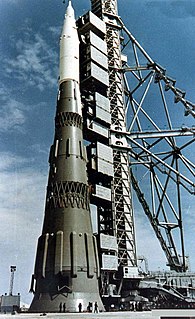
The N1, or Н1 in Russian, was a super heavy-lift launch vehicle intended to deliver payloads beyond low Earth orbit. The N1 was the Soviet counterpart to the US Saturn V and was intended to enable crewed travel to Earth's Moon and beyond, with studies beginning as early as 1959. Its first stage remains the most powerful rocket stage ever built, but all of the four flown N1 Block A first stages failed because of a lack of static test firings which did not reveal plumbing issues and other adverse characteristics with the large cluster of thirty engines and its complex fuel and oxidiser feeder system.

The Apollo command and service module (CSM) was one of two principal components of the United States Apollo spacecraft, used for the Apollo program, which landed astronauts on the Moon between 1969 and 1972. The CSM functioned as a mother ship, which carried a crew of three astronauts and the second Apollo spacecraft, the Apollo Lunar Module, to lunar orbit, and brought the astronauts back to Earth. It consisted of two parts: the conical command module, a cabin that housed the crew and carried equipment needed for atmospheric reentry and splashdown; and the cylindrical service module which provided propulsion, electrical power and storage for various consumables required during a mission. An umbilical connection transferred power and consumables between the two modules. Just before reentry of the command module on the return home, the umbilical connection was severed and the service module was cast off and allowed to burn up in the atmosphere.

The TKS spacecraft was a Soviet spacecraft conceived in the late 1960s for resupply flights to the military Almaz space station.
The Soviet crewed lunar programs were a series of programs pursued by the Soviet Union to land humans on the Moon, in competition with the United States Apollo program to achieve the same goal set publicly by President John F. Kennedy on 25 May 1961. The Soviet government publicly denied participating in such a competition, but secretly pursued two programs in the 1960s: crewed lunar flyby missions using Soyuz 7K-L1 (Zond) spacecraft launched with the Proton-K rocket, and a crewed lunar landing using Soyuz 7K-LOK and LK spacecraft launched with the N1 rocket. Following the dual American successes of the first crewed lunar orbit on 24-25 December 1968 and the first Moon landing on July 20, 1969, and a series of catastrophic N1 failures, both Soviet programs were eventually brought to an end. The Proton-based Zond program was canceled in 1970, and the N1-L3 program was de facto terminated in 1974 and officially canceled in 1976. Details of both Soviet programs were kept secret until 1990 when the government allowed them to be published under the policy of glasnost.
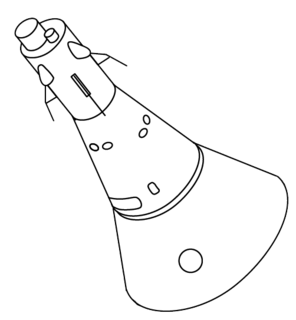
The Vozvraschaemyi Apparat, or VA spacecraft, was a Soviet crew capsule, intended to serve as a crewed launch and reentry vehicle. Initially designed for the LK-1 human lunar flyby spacecraft for one of the Soviet crewed lunar programs, then the LK-700 redesign, it was later repurposed for the Almaz military space station program. The VA capsule on display at the Smithsonian National Air and Space Museum was labeled as Merkur, following a mistranslation of the original documentation – while incorrect, the name is being used in the West for the VA spacecraft and capsule.
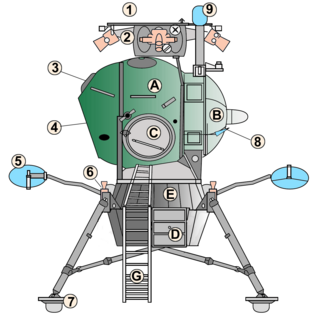
The LK was a lunar module developed in the 1960s as a part of several Soviet crewed lunar programs. Its role was analogous to the American Apollo Lunar Module (LM). Several LK modules were flown without crew in Earth orbit, but no LK ever reached the Moon. The development of the N1 launch vehicle required for the lunar flight suffered setbacks, and the first Moon landings were achieved by US astronauts. As a result, both the N1 and the LK programs were cancelled without any further development.

Kvant-1 (37KE) was the first module to be attached in 1987 to the Mir Core Module, which formed the core of the Soviet space station Mir. It remained attached to Mir until the entire space station was deorbited in 2001.
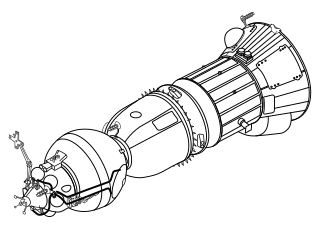
The Soyuz 7K-LOK, or simply LOK was a Soviet crewed spacecraft designed to launch men from Earth to orbit the Moon, developed in parallel to the 7K-L1. The LOK would carry two cosmonauts, acting as a mother ship for the LK Lander which would land one crew member to the surface. It was part of the N1-L3 programme which also included the LK lander and the N1 rocket.
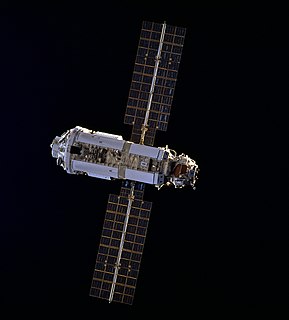
The Functional Cargo Block or FGB was part of the Soviet TKS spacecraft. The TKS spacecraft was intended to be used as a resupply craft for Almaz space stations and saw some test flights in the Salyut space station program. The TKS spacecraft was formed by mating a FGB with a VA spacecraft, with both the VA and the FGB being capable of independent operation.

Saturn V was an American super heavy-lift launch vehicle certified for human-rating used by NASA between 1967 and 1973. It consisted of three stages, each fueled by liquid propellants. It was developed to support the Apollo program for human exploration of the Moon and was later used to launch Skylab, the first American space station.

Orel or Oryol, formerly Federation, and PPTS, is a project by Roscosmos to develop a new-generation, partially reusable crewed spacecraft.
Advanced Gemini is a number of proposals that would have extended the Gemini program by the addition of various missions, including manned low Earth orbit, circumlunar and lunar landing missions. Gemini was the second manned spaceflight program operated by NASA, and consisted of a two-seat spacecraft capable of maneuvering in orbit, docking with unmanned spacecraft such as Agena Target Vehicles, and allowing the crew to perform tethered extra-vehicular activities.
Zvezda moonbase, also called DLB Lunar Base was a Soviet plan and project from 1962 to 1974 to construct a crewed moonbase as successor to the N1-L3 human lunar expedition program. Zvezda moonbase was canceled with the rest of the Soviet human lunar programs.

A super heavy-lift launch vehicle (SHLLV) is a launch vehicle capable of lifting more than 50 tonnes (110,000 lb) of payload into low Earth orbit (LEO).

Soyuz Kontakt(Soyuz Contact) was the docking hardware of the Soviet crewed spacecraft program. The Soviet lunar human program was canceled in 1974 after many failures. Four failures of the N-1 Rocket super heavy-lift launch vehicle and the success of the U.S Apollo program ended the Soviet crewed moon program and the space race.